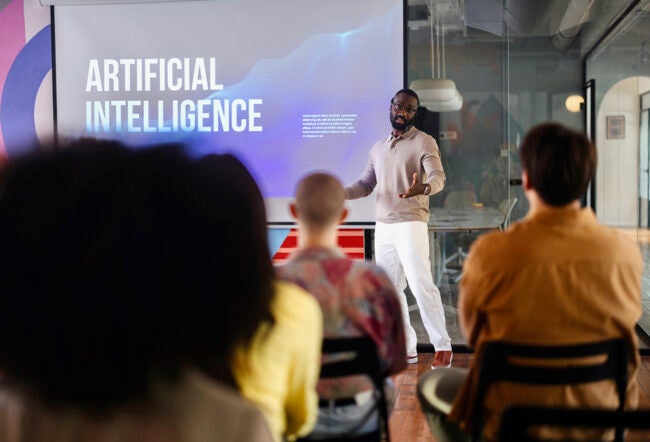After riding a wave of unprecedented industry growth and branching into fiber optics products, an established communications technology manufacturer faces the unthinkable: The market takes a sudden turn for the worse, leading to budget cuts and layoffs across companies in the sector. Meanwhile, the firm’s R&D lab is pushing for the company to invest in a comprehensive expansion of its high-bandwidth fiber optics network to increase consumer access and drive sales. Others at the company strongly disagree, believing that the market for fiber optics has dried up. What should the company do?
According to Wharton management professor Sarah Kaplan, the best answer wouldn’t be immediately clear, and for good reason: Whereas managers often push for quick, bottom-line analysis when facing uncertainty, it might be more beneficial to encourage employees to champion alternative scenarios, or “frames,” as Kaplan and other researchers refer to them. In a new research paper titled, “Framing Contests: Strategy Making under Uncertainty” (forthcoming in the journal Organizational Science), Kaplan details the decision-making process of an actual company (which she calls “CommCorp”) as it faced the bursting of the telecommunications bubble in 2001-2002. What she found was that employees interpreted the market’s ambiguous signals from their own frames of reference and then engaged in a series of “framing activities to mobilize others around a particular point of view.”
Other studies have looked at both the cognitive nature of strategy making at times of uncertainty — including how individuals’ “frames” define what’s at stake and guide decisions — or the political actions taken to determine specific strategy outcomes, but the majority haven’t offered an understanding of how these two elements are, in Kaplan’s words, “deeply intertwined.” Frames that come to predominate and ultimately drive strategy are not the result of static points of view or sheer political maneuvering, but rather emerge from a “dynamic, purposive and politically-charged process …” Kaplan writes. In other words, it’s a contest over what strategies should be pursued — one that needs to be viewed over time. Individuals’ frames can be transformed along the way, as each actor attempts to gain legitimacy for his or her interpretation, until one frame prevails — or, if perspectives don’t come into alignment, a decision could be deferred indefinitely.
Viewing strategy making this way, says Kaplan, challenges traditional notions about hierarchy and power. Whereas senior executives are normally charged with setting direction, especially during turbulent times, the framing contests model pulls into view the roles of all actors within the organization. “Framing contests are not just about senior managers engaging in the symbolic tasks of ‘sensemaking’ and ‘sensegiving’ to lower levels of the organization,” she writes. “Frames are the resources through which actors can gain influence. As a result, power can be accessible to multiple actors. Contesting frames is a way of changing the power structures in the organization.”
And while some managers might shy away from encouraging framing contests because doing so would be “disruptive of day-to-day organizational processes,” Kaplan notes, these debates are not only useful, but necessary. “It would be worrisome if [framing contests] didn’t happen, because the world doesn’t stand still. Businesses can’t always continue to operate as they had in the past.”
A Micro-View
In her analysis of CommCorp, Kaplan writes that she employed observation-based, ethnographic techniques to “uncover ‘the soft underbelly’ … of strategy making by looking at what actors did individually and collectively to construct strategic choices.” Over an eight-month period in 2002, she conducted 80 formal interviews, observed 33 meetings at the company and collected documentation on two key initiatives that were strategic responses to the optical technologies market crash during that time.
To trace how individual frames contributed to strategy decisions, Kaplan looked at specific, key choices that were made in relation to these initiatives, and identified the cognitive frames of the actors involved. These frames were derived from statements made during the interviews, recorded interactions and documents. “It is … useful to conceptualize participants’ frames as the encoding of a variety of previous experiences — including individual career histories, project experience, functional membership, position in the hierarchy — and contexts, including the firm, the industry and the prevailing technological paradigm,” Kaplan writes. “Each of these arenas had its own institutional logic that guided views and behavior.”
An important theme in Kaplan’s research is that frames are not “tools that actors could deploy at will. Observations at CommCorp suggest that an understanding of the sources of frames elucidates their effect in enabling and constraining an individual’s scope of action.” One of the initiatives that Kaplan studied, dubbed “Last Mile,” calls attention to this dual effect of frames. Hugh, a senior scientist in CommCorp’s R&D lab, proposed that the optical market crash should be met with aggressive investment in fiber optic networks to increase consumer access. According to Kaplan, “The contests revolved around differences in frames about the future value of fiber-optics (‘pro-optical’ vs. ‘anti-optical’), the future level of demand (‘market opportunity’ vs. ‘market pessimism’) and about the appropriateness of optical technologies (in particular the ‘OpAccess’ technology that Hugh had previously prototyped) as a solution.”
While Hugh’s pro-optical view guided his data collection efforts and subsequent presentations, employees outside that particular frame weren’t so certain, expressing doubt about whether the larger picture supported his view, or whether there were other, non-optical solutions. Kaplan details the ensuing debates, including a session which Hugh abruptly left “because he felt he could not counter the very strong efforts by opponents to halt the project.”
Coalition Building
Ultimately, Kaplan notes, Hugh and an associate reframed the project so as to minimize opposition and build “a coalition of supporters. The final decision was to make a small investment to support a single product line rather than pursue the originally proposed major development project.”
Kaplan says that it will be years before we know whether or not this was the right move for CommCorp, but the conflict was integral to the process, she notes, citing a statement made by the head of the CommCorp R&D group: “This is not easy. [The] Access [market] is catalytic to the success of the company. So, if there was an easy decision and no pushback, I would be very concerned. But, the fact that there is such emotion and such variety of opinion is a clear and positive indicator that this is an absolutely critical deliverable for the company. I would be worried if [the tension] were not there.”
Kaplan’s analysis of the “Last Mile” initiative reinforces some specific conclusions about framing practices:
- People have a number of frames to draw upon, built up through past experiences across multiple contexts. These frames shape how they see a situation and what strategies they think a company should pursue.
- Just as actors have a repertoire of frames, they have “multiple, sometimes conflicting, interests, only some of which [in the CommCorp example] were relevant in a particular decision context. Some interests were tangible, such as getting a promotion or preserving one’s job. Other interests were intangible, such as being seen as an expert, gaining peer recognition or working on ‘cool projects.’ Other interests had a collective aspect, such as a chance to contribute to the project team or support one’s own functional group,” Kaplan writes.
- Where frames about a decision don’t align within the organization, actors engage in framing practices to increase the resonance of their own frames and mobilize action in a desired direction. Those actors who most skillfully engage in these practices will shape the frame which prevails. Therefore, frames shape strategic choices — not in a deterministic fashion but rather in one mediated by organizational framing contests.
- When framing activities are successful, interests can shift, and new coalitions can form. “Coalitions are built around powerful frames (ones which resonate broadly), and powerful coalitions can shape policy,” Kaplan notes.
The final point is particularly relevant for strategy making, because it highlights how framing contests can lead to new power structures. “[At] CommCorp, power was not something that actors possessed but rather something that occurred in interaction through an actor’s engagement in framing practices.” In other words, strategy decisions don’t rest solely with upper management: “Applying these views to an analysis of organizational strategy making shifts the analytical focus from the firm as a whole to the internal wrangling taking place within a project and from a particular class of executives normally charged with making strategy to the full set of actors involved in shaping a decision.”
No Brainstorming Allowed
Kaplan acknowledges that her study (like other ethnographic studies) has a very specific scope, with its focus on a particular company during an extremely stressful time period. But, she writes, the turbulent market aided her research “because the extremity of the situation heightened the visibility of actors’ cognitive frames. In such circumstances, cognitive frames are less likely to be givens that are embedded in routines and indivisible from interests … and thus their separate effects can be examined.”
She also notes that management research often suggests that fast decisions lead to better performance in turbulent environments, but her study indicates that not only are framing contests inevitable where there is a democratic decision process, they are an essential part of strategy making. Framing contests expose “the critical points of contention,” she says. “You can’t realign frames until you’ve delved into key differences.”
To realize the benefits of framing contests, such conflict needs to be encouraged, she notes. Her first rule of thumb? “Absolutely no ‘quickie’ brainstorming sessions,” she says. “People schedule themselves for two hours and expect to have brilliant ideas. It can’t happen in one session — it’s a process.” Instead, she suggests that managers plan a series of meetings and events that are not tied to regular operating goals, interspersed with periods for new data collection, analysis and reflection. “Plan a lot of them,” she says.
In terms of developing new frames and seeing the world in new ways, Kaplan suggests that managers “experience new data, instead of just reading about things. Go out into the world and look at things differently — visit a company that does something completely different from yours but has some common threads. Visit other divisions of your company to see what other frames are operating.”
Finally, Kaplan suggests that CEOs not always push for a quick answer or “the bottom line.” “Take time to find out what the alternate scenarios are,” she says. “This may appear to be deeply inefficient, but in fact going slow up front might help you go faster down the line.”
Framing Contests: Strategy Making Under Uncertainty



